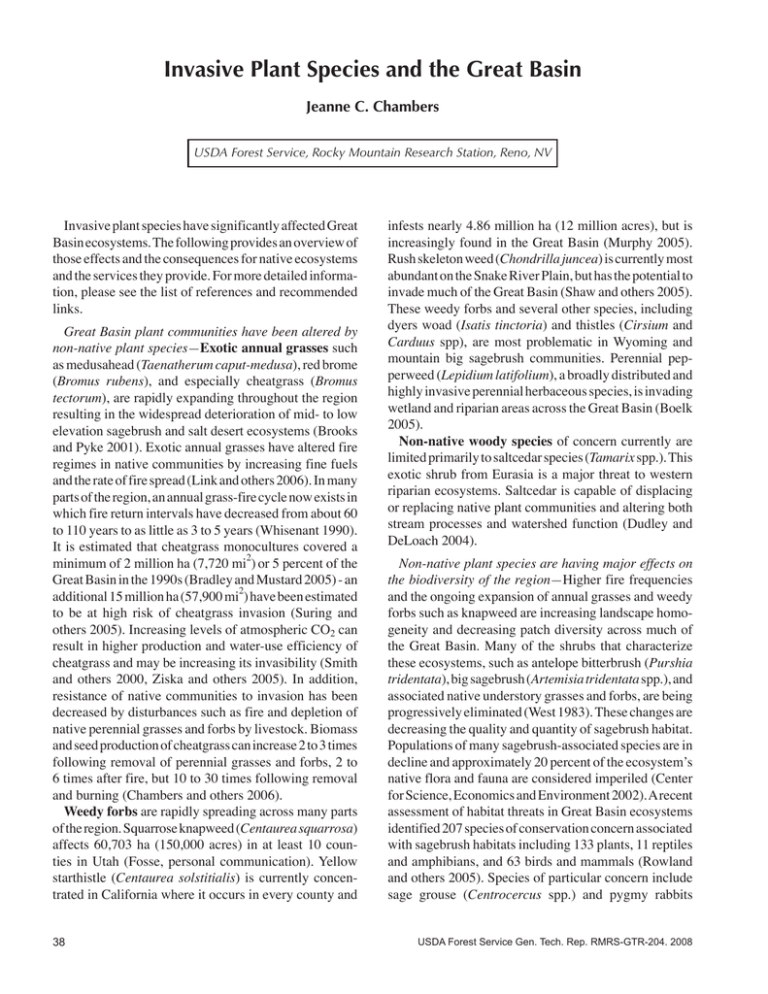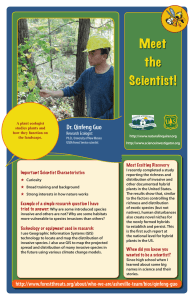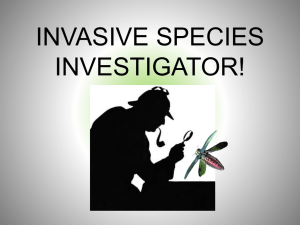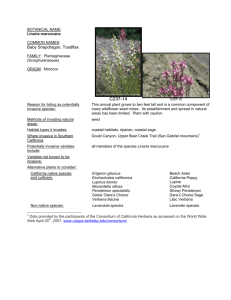Invasive Plant Species and the Great Basin Jeanne C. Chambers
advertisement

Invasive Plant Species and the Great Basin Jeanne C. Chambers USDA Forest Service, Rocky Mountain Research Station, Reno, NV Invasive plant species have significantly affected Great Basin ecosystems. The following provides an overview of those effects and the consequences for native ecosystems and the services they provide. For more detailed information, please see the list of references and recommended links. Great Basin plant communities have been altered by non-native plant species—Exotic annual grasses such as medusahead (Taenatherum caput-medusa), red brome (Bromus rubens), and especially cheatgrass (Bromus tectorum), are rapidly expanding throughout the region resulting in the widespread deterioration of mid- to low elevation sagebrush and salt desert ecosystems (Brooks and Pyke 2001). Exotic annual grasses have altered fire regimes in native communities by increasing fine fuels and the rate of fire spread (Link and others 2006). In many parts of the region, an annual grass-fire cycle now exists in which fire return intervals have decreased from about 60 to 110 years to as little as 3 to 5 years (Whisenant 1990). It is estimated that cheatgrass monocultures covered a 2 minimum of 2 million ha (7,720 mi ) or 5 percent of the Great Basin in the 1990s (Bradley and Mustard 2005) - an additional 15 million ha (57,900 mi2) have been estimated to be at high risk of cheatgrass invasion (Suring and others 2005). Increasing levels of atmospheric CO2 can result in higher production and water-use efficiency of cheatgrass and may be increasing its invasibility (Smith and others 2000, Ziska and others 2005). In addition, resistance of native communities to invasion has been decreased by disturbances such as fire and depletion of native perennial grasses and forbs by livestock. Biomass and seed production of cheatgrass can increase 2 to 3 times following removal of perennial grasses and forbs, 2 to 6 times after fire, but 10 to 30 times following removal and burning (Chambers and others 2006). Weedy forbs are rapidly spreading across many parts of the region. Squarrose knapweed (Centaurea squarrosa) affects 60,703 ha (150,000 acres) in at least 10 counties in Utah (Fosse, personal communication). Yellow starthistle (Centaurea solstitialis) is currently concentrated in ­California where it occurs in every county and 38 infests nearly 4.86 million ha (12 million acres), but is increasingly found in the Great Basin (Murphy 2005). Rush skeleton weed (Chondrilla juncea) is currently most abundant on the Snake River Plain, but has the potential to invade much of the Great Basin (Shaw and others 2005). These weedy forbs and several other species, including dyers woad (Isatis tinctoria) and thistles (Cirsium and Carduus spp), are most problematic in Wyoming and mountain big sagebrush communities. Perennial pepperweed (Lepidium latifolium), a broadly distributed and highly invasive perennial herbaceous species, is invading wetland and riparian areas across the Great Basin (Boelk 2005). Non-native woody species of concern currently are limited primarily to saltcedar species (Tamarix spp.). This exotic shrub from Eurasia is a major threat to western riparian ecosystems. Saltcedar is capable of displacing or replacing native plant communities and altering both stream processes and watershed function (Dudley and DeLoach 2004). Non-native plant species are having major effects on the biodiversity of the region—Higher fire frequencies and the ongoing expansion of annual grasses and weedy forbs such as knapweed are increasing landscape homogeneity and decreasing patch diversity across much of the Great Basin. Many of the shrubs that characterize these ecosystems, such as antelope bitterbrush (Purshia tridentata), big sagebrush (Artemisia tridentata spp.), and associated native understory grasses and forbs, are being progressively eliminated (West 1983). These changes are decreasing the quality and quantity of sagebrush habitat. Populations of many sagebrush-associated species are in decline and approximately 20 percent of the ecosystem’s native flora and fauna are considered imperiled (Center for Science, Economics and Environment 2002). A recent assessment of habitat threats in Great Basin ecosystems identified 207 species of conservation concern associated with sagebrush habitats including 133 plants, 11 reptiles and amphibians, and 63 birds and mammals (Rowland and others 2005). Species of particular concern include sage grouse (Centrocercus spp.) and pygmy rabbits USDA Forest Service Gen. Tech. Rep. RMRS-GTR-204. 2008 (­ Brachylagus idahoensis) (Knick and others 2003). One of the major risks to these species is continued habitat displacement by cheatgrass (Rowland and others 2005). Many of the weedy forbs expanding in the Great Basin exist in monocultures that exclude native vegetation and degrade wildlife habitat. Perennial pepperweed and Tamarisk may be contributing to the decline of many native plant and animal species associated with riparian areas (Young and others 1995, Dudley and DeLoach 2004). Invasive plant species are decreasing the capacity of native ecosystems to provide important ecosystem services—In addition to the loss of habitat and biodiversity, invasive plant species can impact local communities and agencies by decreasing watershed function and rangeland productivity and increasing fire frequency. Conversion of sagebrush ecosystems to annual grass or weedy forb dominance has altered watershed functioning. Soil and water losses have occurred where tap-rooted weeds such as knapweed and yellow starthistle have replaced native grasses. Surface water runoff and soil erosion were 56 and 192 percent higher, respectively, on spotted knapweed dominated rangeland compared to native bunchgrass dominated sites (Lacey and others 1989). Invasive annual grasses can effectively stabilize topsoil, but loss of vegetative cover following fires or other disturbances can increase overland flow and surface erosion (Knapp 1996). Thus, conversion to annual grasses or weedy forbs can result in loss of soil nutrients, siltation of streams and rivers, and increased susceptibility to flooding (Knapp 1996). More frequent fires associated with cheatgrass invasion can result in increased costs for land management agencies and lost revenues for local communities. In 2006, 526,000 ha (1.3 million acres) burned in Elko County, Nevada, prompting the Department of Wildlife to release additional hunting permits and to transplant animals (pronghorn antelope) out of the area. These types of large fires are increasing emergency rehabilitation efforts across the region with over $19 million spent annually on restoration of sagebrush ecosystems (BLM internal report). Despite these efforts, areas with low precipitation remain extremely difficult to rehabilitate/restore after type conversion to annual weeds. Type conversion to annual grasses or weedy forbs decreases forage quality and availability for livestock. Local communities benefit from money spent for fire suppression, but can suffer from property loss associated with wildfires, health and safety risks due to smoke and particulate matter, and a loss of recreational value and income. USDA Forest Service Gen. Tech. Rep. RMRS-GTR-204. 2008 Management Challenges Prevention—Collaborative partnerships are needed to conduct species risk assessments, identify priority invasive species and areas at risk of invasion, and develop and implement prevention programs that include public education. Early detection and rapid response—Collaborative partnerships are needed to develop methods for quickly and accurately detecting introductions of invasive species, for assessing if the introductions are in priority or high risk ecosystems, and for assembling rapid response teams that cross jurisdictional boundaries to respond to new introductions. Control and management—A comprehensive assessment of invasive species is needed to identify priority species and areas for program focus. An understanding of the mechanisms of invasive species expansion coupled with integrated control strategies (biological, cultural, chemical, and physical) are needed for effective management. Long-term monitoring programs are needed to evaluate changes in species distributions or abundances and the effects of control efforts. Rehabilitation and restoration—Collaborative partnerships are needed to select native plant species that can establish and persist under competition from non-native invaders; develop an infrastructure for producing, purchasing, and warehousing seed supplies of native plants; and develop methods for reestablishing and maintaining native plant communities. Research and Management Questions What are the effects of climate change on species invasions? What are the effects of land use (societal patterns and development patterns) on species invasions? What are the rates of expansion of invasive plant species, types of management activities that increase invasion rates, and types of ecosystems where expansion is occurring most rapidly? What ecosystem properties/processes convey resistance or susceptibility to invasion? What ecosystems are at greatest risk of invasion? What attributes of invasive species allow successful invasion of the Great Basin? What are the effects of invasive species on watershed function and water resources? 39 What are the effects of invasive species on plant communities and biodiversity? What are the effects of invasive species with different life forms, annual grasses, weedy forbs, and woody species on fire regimes? Can changes in current management activities be used to decrease the rates of invasion sustain native and ­ecosystem? What are the most appropriate scales and stages of invasion at which to target control activities? What are the most effective methods or integrated methods for controlling priority invasive species? What are the most effective methods for reestablishing native species while controlling invasive species? What are the effects of efforts to control invasive species on native plant communities and biodiversity? Existing Programs and Resources USDA Agricultural Research Service. Exotic and Invasive Weeds Research Unit. 19 http://www.ars.usda. gov/main/site_main.htm?modecode=53-25-43-00 [2007, July 17] USDA Forest Service, Rocky Mountain Research Station. Great Basin Ecology Lab. http://www.ag.unr.edu/ gbem/ [2007, July 17] USDA Forest Service, Rocky Mountain Research Station. Shrub Sciences Lab 30 Aug. 2006. http://www. fs.fed.us/rm/provo/ [2007, July 17] USDI Bureau of Land Management Great Basin Restoration Initiative. http://www.fire.blm.gov/gbri/ [2007, July 17] U.S. Geological Survey, Western Ecological Research Center. Invasive Species Research. 31 Oct. 2002. http:// www.werc.usgs.gov/invasivespecies/ [2007, July 17] U.S. Geological Survey, Forest and Rangeland Ecosystem Science Center, Coordinated Intermountain Restoration Project: 30 June 2003. http://fresc.usgs.gov/research/ StudyDetail.asp?Study_ID=305 [2007, July 17] The Nature Conservancy, Global Invasive Species Initiative (ISI). http://tncweeds.ucdavis.edu [2007, July 17] Plant Conservation Alliance. Alien Plant Working Group; Alien Plant Invaders of Natural Areas. Fact sheets, plant lists, and background information. http://www.nps. gov/plants/alien/ [2007, July 17]. 40 Center for Invasive Plant Management. Fighting weeds in the western United States. http://www.weedcenter.org/ [2007, July 17] USDA Forest Service. Fire Effects Information System. http://www.fs.fed.us/database/feis/ [2007, July 17] Provides up-to-date information about fire effects on animals and plants. University of Montana, Missoula. Invaders Database System. Noxious weed lists, and weeds of the northwest United States. http://invader.dbs.umt.edu/ [2007, July 17] Idaho Weed Control Association. http://idahoweedcontrol.org/ [2007, July 17] USDA Natural Resources Conservation Service. PLANTS database. A good extensive database with noxious weed lists for all Great Basin states. http://plants. usda.gov/ [2007, July 17] USDA National Agricultural Library. National Invasive Species Information Center. 2 May 2007. http://www. invasivespeciesinfo.gov/index.shtml [2007, July 17] Invasive species information; covering Federal, State, local, and international sources. Southwest Exotic Plant Information Clearinghouse. http://sbsc.wr.usgs.gov/ research/projects/swepic/swepic.asp [2007, July 17] U.S. Geological Survey, Fort Collins Science Center. Invasive Species Science. http://www.mesc.usgs.gov/ ISS/ [2007, July 17] Strategic Plans USDA Forest Service. 2004. National strategy and implementation plan for invasive species management. FS-805. Available: http://www.fs.fed.us/rangelands/ftp/ invasives/documents/Final_National_Strategy_100804. pdf [2007, July 17] State of Idaho. 2005. Idaho’s Action Plan for Invasive Species. http://www.idl.idaho.gov/invasivespecies/invasive_species_resources/idaho_invasive_species_plan. pdf [2007, July 17] References Boelk, D. A. 2005. Fact Sheet: Perennial pepperweed. Alien Plant Working Group. Weeds Gone Wild: Alien Plant Invaders of Natural Areas. [Webpage of the Alien Plant Working Group], [Online]. Available: http://www.nps.gov/plants/alien/fact/lela1.htm [2007, July 17]. Bradley, B. A.; Mustard, J. F. 2005. Identifying land cover variability distinct from land cover change: cheatgrass in the Great Basin. Remote Sensing of Environment. 94: 204-213. USDA Forest Service Gen. Tech. Rep. RMRS-GTR-204. 2008 Brooks, M. L.; Pyke, D. A. 2001. Invasive plants and fire in the deserts of North America. Pages 1-14. In: Galley, K. M.; Wilson, T. P., eds. Proceedings of the Invasive Species Workshop: the Role of Fire in the Control and Spread of Invasive Species. Fire Conference 2000: the First National Congress on Fire Ecology, Prevention, and Management.; 2000 November 27-December 1; San Diego, CA. Misc. Publ. No. 11, Tallahassee, FL: Tall Timbers Research Station: 1-14. Bureau of Land Management. Internal Report. Center for Science, Economics and Environment. 2002. The state of the nation’s ecosystems: measuring the lands, waters and living resources of the United States. Cambridge, United Kingdom: Cambridge University Press. 288 p. Available: http://www.heinzctr.org/ ecosystems/report.html, with 2005 updates [2007, July 17]. Chambers, J. C.; Roundy, B.A.; Blank, R. R.; Meyer, S. E.; Whittaker, A. 2006. What makes Great Basin sagebrush ecosystems invasible by Bromus tectorum? Ecological Monographs. 77:117-145. Dudley, T. L.; DeLoach, C. J. 2004. Saltcedar (Tamarix spp.) Endangered species and biological weed control- can they mix. Weed Technology. 18: 1542-1551. Knapp, P. A. 1996. Cheatgrass (Bromus tectorum L.) dominance in the Great Basin desert. Global Environmental Change. 6:37-52. Knick, S. T.; Dobkin, D. S.; Rotenberry, J. T.; Schroeder, M. A.; Vander Haegen, W. Matthew; Van Riper III, C. 2003. Teetering on the edge or too late? Conservation and research issues for avifauna of sagebrush habitats. The Condor. 105: 611-634. Lacey, J. R.; Marlow, C. B.; Lane, J. R. 1989. Influence of spotted knapweed (Centaurea maculosa) on surface water runoff and sediment yield. Weed Technology. 3: 627-631. Link, S. O.; Keeler, C. W.; Hill, R. W.; Hagen, E. 2006. Bromus tectorum cover mapping and fire risk. International Journal of Wildland Fire. 15:113-119. Murphy, A. 2005. Fact Sheet: yellow starthistle. Alien Plant Working Group. Weeds Gone Wild: Alien Plant Invaders of Natural Areas. [Webpage of the Alien Plant Working Group], [Online]. Available: http://www.nps.gov/plants/alien/fact/ceso1.htm [2007, July 17]. Rowland, M. M.; Suring, L. H.; Wisdom, M. J.; Meinke, C. W.; Schueck, L. 2005. Habitats for vertebrate species of concern. In: Wisdom, M. J.; Rowland, M. M.; Suring, L. H., eds. 2005. Habitat USDA Forest Service Gen. Tech. Rep. RMRS-GTR-204. 2008 threats in the sagebrush ecosystem: methods of regional assessment and applications in the Great Basin. Lawrence, KS: Alliance Communications Group, Allen Press: 163-204. Shaw, N. L.; Lambert, S. M.; DeBolt, A. M.; Pellant, M. 2005. Increasing native forb seed supplies for the Great Basin. In: Dumroese, R. K.; Riley, L. E.; Landis, T. D., tech. coords. 2005. National proceedings: Forest and Conservation Nursery Associations—2004; 2004 July 12–15; Charleston, NC; and 2004 July 26–29; Medford, OR. Proc. RMRS-P-35. Fort Collins, CO: U.S. Department of Agriculture, Forest Service, Rocky Mountain Research Station: 94-102. Smith, S. D.; Huzman, T. E.; Zitzer, S. F.; Charlet, T. N.; ­Housman, D. C.; Coleman, J. S.; Fenstermaker, L. K.; Seeman, J. R.; and Nowak, R. S. 2000. Elevated CO2 increases productivity and invasive species success in an arid system. Nature. 408: 79-81. Suring, L. H.; Wisdom, M. J.; Tausch, R. J [and others]. 2005. Modeling threats to sagebrush and other shrubland communities. In: Wisdom, M. J.; Rowland M. M.; Suring, L. H., eds. Habitat threats in the sagebrush ecosystems: methods of regional assessment and application in the Great Basin. Lawrence, KS: Alliance Communications Group, Allen Press. 114-119. West, N. E. 1983. Great Basin-Colorado Plateau sagebrush semi-desert. In: N. E. West, ed. Temperate deserts and semi-deserts. Amsterdam, The Netherlands: Elsevier Publishing Company: 331-349. Whisenant, S. G. 1990. Changing fire frequencies on Idaho’s Snake River Plains: ecological and management implications. In: ­McArthur, E. D.; Romney, E. M.;Smith, S. D.; Tueller, P. T., comps. Proceedings – Symposium on cheatgrass invasion, shrub die-off and other aspects of shrub biology and management. Gen. Tech. Rep. INT-276. Ogden, Utah: U.S. Department of Agriculture, Forest Service, Intermountain Research Station. 4-10. Young, J. A.; Turner, C. E.; James, L. F. 1995. Perennial pepperweed. Rangelands. 17: 121-123. Ziska, L. H.; Reeves, J. B.; Blank, R.R. 2005. The impact of recent changes in atmospheric CO2 on biomass production and vegetative retention of cheatgrass (Bromus tectorum): implications for fire disturbances. Global Change Biology. 11:1325-1332. 41







